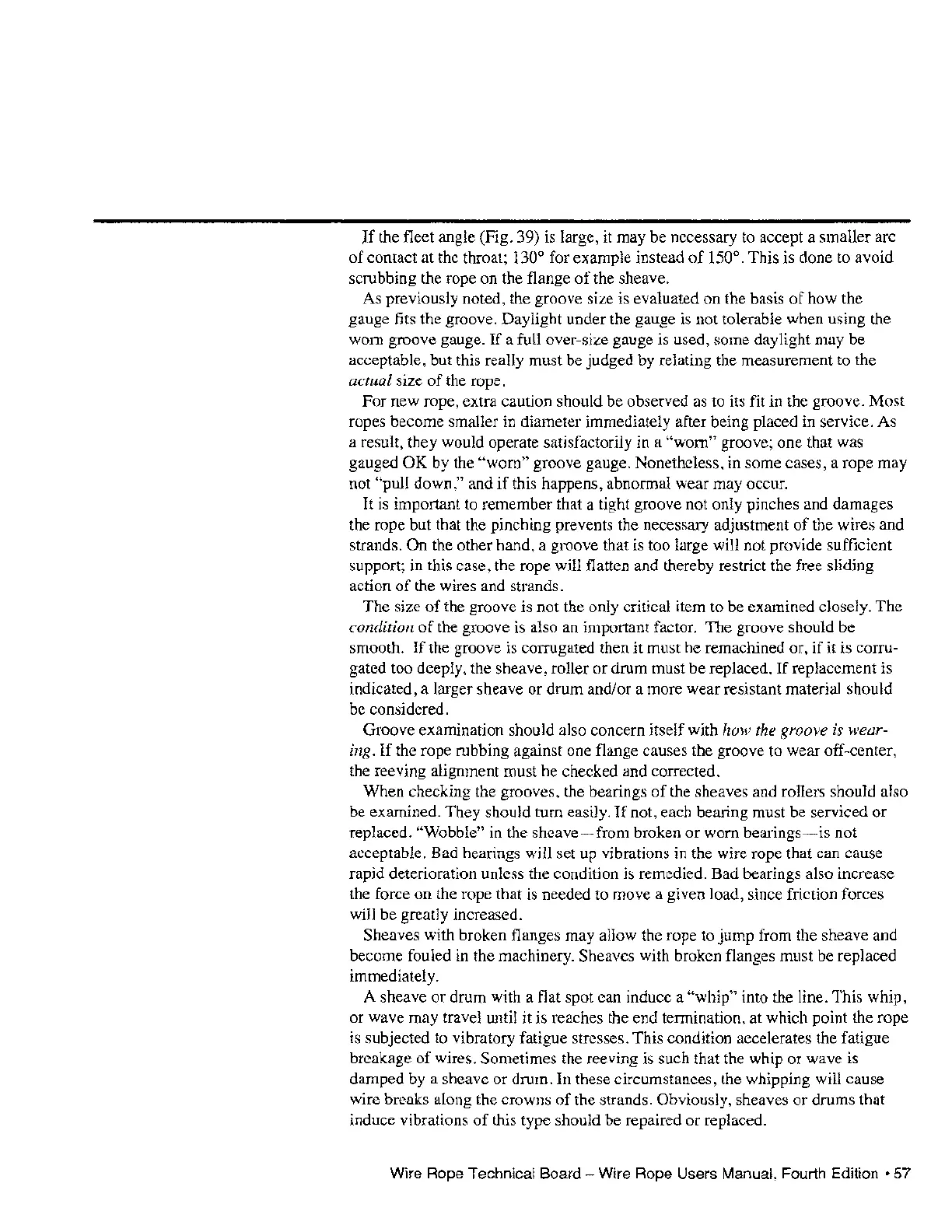If
the fleet angle (Fig. 39) is large, it may be necessary to accept a smaller arc
of
contact at the throat;
1300
for example instead
of
150
0
.
This is done to avoid
scrubbing the rope on the flange
of
the sheave.
As previously noted, the groove size is evaluated on the basis
of
how the
gauge fits the groove. Daylight under the gauge is not tolerable when using the
worn groove gauge.
If
a full over-size gauge is used, some daylight may
be
acceptable, but this really must be judged by relating the measurement to the
actual size
of
the rope.
For new rope, extra caution should be observed as to its fit in the groove. Most
ropes become smaller in diameter immediately after being placed in service. As
a result, they would operate satisfactorily in a
"worn" groove; one that was
gauged
OK by the "worn" groove gauge. Nonetheless, in some cases, a rope may
not
"pu1l down," and
if
this happens, abnormal wear may occur.
It is important to remember that a tight groove not only pinches and damages
the rope but that the pinching prevents the necessary adjustment
of
the wires and
strands.
On the other hand, a groove that
is
too large will not provide sufficient
support; in this case, the rope will flatten and thereby restrict the free sliding
action
of
the wires and strands.
The size
of
the groove is not the only critical item to be examined closely. The
condition
of
the groove is also an important factor. The groove should be
smooth.
If
the groove is corrugated then
it
must be remachined or,
if
it is corru-
gated too deeply, the sheave, roller or drum must be replaced.
If
replacement is
indicated, a larger sheave or drum and/or a more wear resistant material should
be considered.
Groove examination should also concern itself with
how the groove is wear-
ing.
If
the rope rubbing against one flange causes the groove to wear off-center,
the reeving alignment must be checked and corrected.
When checking the grooves, the bearings
of
the sheaves and rollers should also
be examined. They should turn easily.
If
not, each bearing must be serviced
or
replaced. "Wobble" in the
sheave-from
broken or worn
bearings-is
not
acceptable. Bad bearings will set up vibrations in the wire rope that can cause
rapid deterioration unless the condition is remedied. Bad bearings also increase
the force on the rope that is needed to move a given load, since friction forces
will be greatly increased.
Sheaves with broken flanges may allow the rope to jump from the sheave and
become fouled in the machinery.
Sheaves with broken flanges must be replaced
immediately.
A sheave or drum with a flat spot can induce a
"whip" into the line. This whip,
or wave may travel until
it is reaches the end termination, at which point the rope
is subjected to vibratory fatigue stresses. This condition accelerates the fatigue
breakage
of
wires. Sometimes the reeving is such that the whip or wave is
damped by a sheave or drum. In these circumstances, the whipping will cause
wire breaks along the crowns
of
the strands. Obviously, sheaves or drums that
induce vibrations
of
this type should be repaired or replaced.
Wire Rope Technical Board - Wire Rope Users Manual, Fourth
Edition'
57
